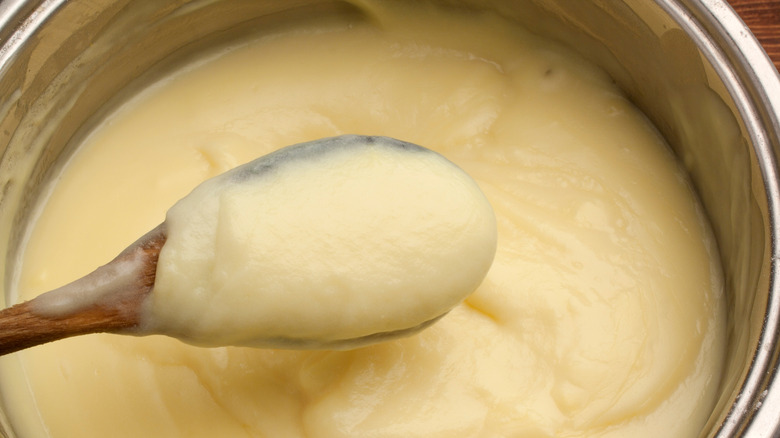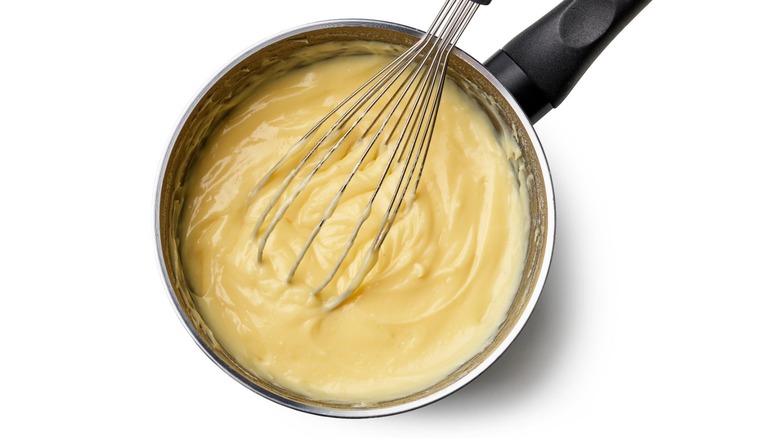Why You Should Never Store Custard Desserts In The Freezer
Whisk together milk and cream with sugar, then add egg yolks to thicken. Follow it up with maybe a droplet or two of vanilla extract for fragrance and you get a bowlful of one of the best pastry fillings out there: Custard. From the classic French crème brûlée with its caramelized sugar crust to the American egg custard pie and the crispy, semolina-wrapped Greek galaktoboureko, custard is the extra touch of sugary creaminess that makes all these desserts the delicious eats that they are.
Let's say that you've baked a big batch for a house party and now that everyone's gone home, you found out you've got some leftover custard desserts. If your instinct is to chill it down to keep it around for longer, you got that right! However, custard should only ever go into the fridge — never the freezer! (One exception is if it's an icebox cake or other recipe that's intended to be kept frozen.)
You see, custard is incredibly temperature-sensitive. When frozen, the fat and water separate. So, instead of having the silky texture it had when fresh out of the pot, you'll get scrambled-egg-like lumps and a bunch of sugary water when you thaw it out.
The science of syneresis
Syneresis is what you call the phenomenon when liquid separates and seeps out from food. Custard has a lot of water thanks to the addition of whole milk. When you prepare custard perfectly, the egg proteins arrange themselves neatly into a microscopic structure that can trap and hold onto water molecules. This gives the custard its signature velvety, gel-like texture.
However, imagine this structure like a house of cards. Any big changes made to the custard and this structure will collapse, causing the proteins to lose the ability to hold water, and boom — the proteins and the water split. Typically, this happens because of extreme temperature changes, like the custard being cooked too hot or chilled too cold.
When you overcook custard, the egg proteins will clump together and "squeeze" out all the water between them. That's why a failed batch of custard will look runny in the pot. When you freeze custard, ice crystals form in between the egg proteins and disrupt the bonds between the molecules. When you finally thaw out the custard, the proteins — now with gaping holes in between them — can't interlock with each other like before. Water just freely leaks through these holes and they split.
How do you rescue a batch of split custard?
If you've already incorporated a split, watery custard from the freezer into a pie or other dessert, it's likely beyond saving. In those cases, it's best to chalk it up as a learning experience and start fresh. However, if your custard is still on its own — not yet added into a recipe — there's hope! The idea is simple: Re-heat the egg proteins so that they regain their water-absorbing micro-structure, and they should be good to go again.
First, pour the split custard, water and all, into a saucepan and place it over low heat. Stir frequently, about every 30 seconds, to prevent scorching. As the custard begins to warm, gradually increase the heat and continue stirring for about 2 minutes. Next, for every 7 ounces of custard, add a tablespoon of warm whole milk to the saucepan. This added milk will help the proteins realign and bind the liquids together again. Keep whisking, and you'll soon see the custard regain its original velvety, gel-like consistency.
Bring it off the heat before it can boil (or it will split again!) and use it to fill whichever pastry you have in mind. And of course, the next time, remember to store it in the fridge.


